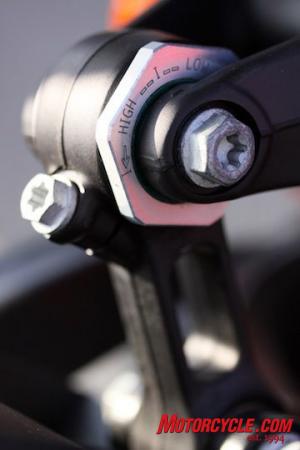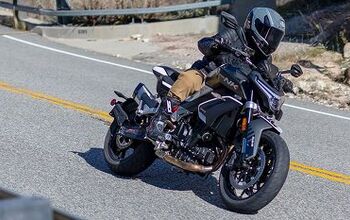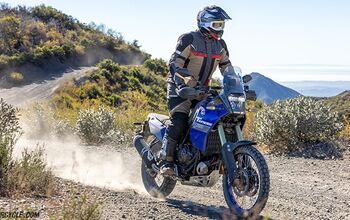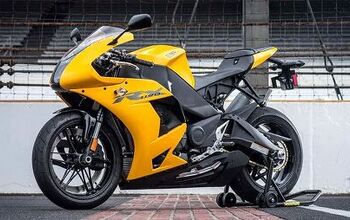2010 KTM 1190 RC8R Review - Motorcycle.com
I've fallen in lust with enough Ducatis over the years that I'm skeptical about competition from any other European V-Twin sportbike contender. How could any company compete with Ducati's legendary race history and artful, sensuous styling?
Well, KTM, long known only for its highly capable off-road bikes, is doing it by being different – mostly. One look at the 2010 KTM 1190 RC8R is all it takes to know that it wasn't designed by an Italian. KTM is based in Austria (as is designer Gerald Kiska who has worked with KTM since 1991) just a day ride over Stelvio Pass from Italy, but there's no mistaking KTM's non-Italian Teutonic design language. Perhaps the distinctive design of the RC8R is the result of Austria’s location snuggled between Italy and Germany: the cold, engineering-driven German influence blended with the romance of Latin Europe.
The RC8R’s chiseled design creates a sensation wherever it stops. If an F-117 stealth fighter crashed into a motorcycle factory, the RC8R would be the likely result. Slim and angular, and swaddled with matte-black paint, it looks stealthy, even if its radar-evading qualities are dubious. Although few would describe the black and orange machine as “pretty,” we admire the courage to step outside of the well-worn sportbike design box with its bold origami shape. Opinions vary.
“Angular shapes and bold use of black, white and orange color scheme makes the KTM a clear standout in styling in the liter class, possibly rivaled only by BMW’s new S1000RR,” says MO’s Senior Editor, Pete Brissette.
“They say there’s a fine line separating genius from lunacy, and for the RC8 there’s a fine line between distinctive styling from downright repugnance – you choose,” observes Tom Roderick, MO guest rider and freelance journalist.
Like the Ducati, KTM’s top-line superbike is powered by a liquid-cooled V-Twin, although here, too, it is done a little different. Its cylinders are set at 75 degrees rather than the Duc's traditional 90-degree Vee for a more compact arrangement. The non-R RC8 makes do with 1148cc and 15 horsepower less than the R’s claimed 170 crankshaft hp made at 10,250 rpm. The R has several high-tech features such as titanium intake valves, a lofty 13.5:1 compression ratio and a low-friction DLC treatment on its camshafts’ finger followers. Peak torque of 90.7 ft-lbs from the Rotax engine is said to arrive at 8000 rpm. We discovered nearly 150 horses pushing the back wheel when we had four-time AMA tuner of the year Carry Andrew strap it to the Hypercycle dyno.
While KTM builds its own frames from large-tube chromoly steel, it sources high-end componentry from world leaders like Brembo and Marchesini across the Dolomite Mountains. Fuel injection comes from Keihin in Japan.
Adjustment Attitude
We’ve whined for years about the lack of ergonomic adjustments on motorcycles, a one-size-fits-all philosophy. Over the past couple of years, we’ve been lauding recently added features such as adjustable seat heights (BMW, Honda ST1300, Yamaha FJR, FZ6R) and foot controls ( Suzuki GSX-R, Yamaha R1).
Well, KTM has one-upped them all with the variety of ways to custom fit an RC8R to its riders. Here’s a list of components to adjust.
Front brake lever: Nearly ubiquitous, so no major bonus points there.
Clutch lever: Surprisingly still unavailable on many modern motorcycles.
Handlebars: The conversion from almost sport-tour-y to racebike is accomplished with four bolts and fewer minutes.
Seat: Not just the seat but the entire subframe, altering seat height from 31.7 to 32.5 inches in mere minutes.
Footpegs: Lots of legroom when set in their lowest position yet still difficult to drag. Virtually unlimited ground clearance when in their high position.
Shifter: Adjustable for length (3 positions), leverage and GP-shift conversion.
Brake pedal: Nub adjustable for length in 3 positions.
Rear ride height: An eccentric allows simple adjustment over a 12mm range.
Gauges: Separate displays for street or track, most available via a pair of toggles on the left clip-on. The Road setting has displays for tripmeters, clock, fuel mileage, miles to empty (best- and worst-case scenarios), trip time and ambient temps. The track setting has displays for lap timers, top speed, max rpm and race duration.
Ergonomically, much depends on how the RC8R is set up (see above sidebar). With the subframe in its high position and footpegs low, the RC8 has more legroom than any supersports bike. Short riders will likely prefer the tailsection in its lower position to make flat-footing possible. With the clip-ons in their high setting, visions of a 500-mile day seem possible. A narrow but tall windscreen delivers a large amount of wind protection relative to other bikes in the class.
The eager V-Twin always fires up in less than one second, quickly emitting a staccato bark from the under-engine muffler (thanks, Erik Buell). Throttle response is incredibly immediate, exhibiting minimal flywheel effect as the revs climb and fall instantaneously. An LCD bar-graph tachometer is placed at the top of the techie gauge panel but is too small to be readily seen. Optimal upshifts are enabled by a prominent shift light.
The RC8R was introduced two seasons ago but didn’t make the trip to America until the 2010 model year. Revisions to the original model include stiffer clutch springs to better transmit the 5 extra horsepower on tap. Pull from the radial-mount clutch master cylinder is moderate, but we wish its engagement point wasn’t at the end of its travel. Still, a wide engagement zone aids quick launches, and gobs of low-end steam will have the front wheel off the ground before you’re halfway across an intersection.
But you will need a practiced set of hands to be smooth on the Katoom. A light throttle spring and negligible flywheel weight conspires with snatchy fuel injection to make for a herky-jerky ride if not finessed, and it surges at low rpm while putting around town.
“At the low end of the rev range, the KTM is incapable of providing a smooth transition from no or minimal throttle to corner-exiting acceleration,” says T-Rod. “This could be a problem with the fuel injection or the throttle itself as there is next to no spring tension when twisting the grip, making smooth throttle application a chore even for an experienced motorcyclist.”
But once underway, the Twin is nothing but enthralling. A massive amount of low-end twist causes the front end to easily come up in first gear, even with the throttle at 50%. Bang an early upshift to keep it from flipping over and orange-crushing its rider, and the front wheel comes up again, although this time a little slower.
With the engine spinning just under 5000 rpm at 80 mph, roll-on power is astounding – it pulls so hard that I several times prodded the shifter up to access another gear that wasn’t there, yet another reason why we like gear-position indicators and why we wish the RC8 had one.
Vibration from KTM’s V-Twin is more prominent than from the smoother 90 degrees of a Ducati Twin and its perfect primary balance, and this presents itself through the handlebars and footpegs at various engine speeds. It’s more noticeable than objectionable for most. “Although a rider can acclimate to vibration produced from the KTM’s 75-degree Vee,” Pete notes, “the vibe is notably more than on a Ducati 1198.”
Early RC8s were chastised for a sub-par gearbox, so KTM made several internal transmission mods to improve shift quality for 2010 models. Shift effort is light and mostly precise, although clutchless upshifts were occasionally but not always reluctant. Accessing neutral at a stop was often frustrating.
When it’s time to hit some twisty roads, the RC8R responds with agility heretofore unknown from a liter-sized V-Twin. A reduced triple-clamp offset increases trail from 91mm to 97mm for better front-end feel, but its rake is set at a very steep 23.3-degree angle. It steers nicely, arcing quickly and gracefully through corners. “With the RC8R’s sharp and precise steering,one can change direction just by a slight shift of his/her body,” comments perennial test rider and all-around good guy Kaming Ko. “I absolutely love riding this bike.”
The RC8’s composure is aided by dampers from WP suspension, a subsidiary of KTM. A premium 43mm inverted fork leads the way, and a titanium-aluminum-nitride coating on its sliders contribute to a responsive ride. A high-end WP shock suspends the RC’s rear, and its piston rod is also finished with the TiAIN low-stiction coating. The fork has three modes of adjustment (compression and rebound damping and spring preload), while the shock separates the compression damping into high and low speed circuits and has the aforementioned ride-height adjustability. An adjustable steering damper completes the WP fitment.
As delivered, the suspension was firm yet relatively compliant on the smooth roads of northern San Diego County, but we judged the setup was too stiff once we traversed bumpier pavement. Too stiff, also, for the gnarled tarmac at Buttonwillow Raceway with our lightweight riders aboard. Thankfully, Race Tech’s Lenny Albin was at the track, and a few twists and turns of his expert wrenches quickly yielded a much more compliant ride.
We’ve said it before and we’ll say it again: A properly set-up suspension can transform an evil bike into a dreamboat, so be sure to spend the time and/or money to get yours dialed in for your weight and riding style.
The RC8R’s suspension is encumbered by a minimal amount of weight, as KTM has spent money on lightweight parts where they matter most. The RC8's cast-aluminum wheels are upgraded with forged-aluminum hoops from Marchesini. The 6-inch rear is only 0.7 lb lighter, but the front is a massive 1.6 lbs less weighty, and this pays dividends with reduced steering effort and better suspension control. Pirelli Diablo Supercorsa SP tires are each 100 grams lighter than the Supercorsa Pros on the regular RC8, and a carbon-fiber front fender knocks off another 100 grams. KTM says the RC8R scales in at 401 lbs without fuel, so we expect it to weigh nearly 430 lbs with its 4.3-gallon tank full. It averaged nearly 40 mpg in our hands.
Top-shelf braking components also grace the RC8R. A radial master cylinder actuates Brembo’s terrific monoblock calipers to bite on 320mm discs, the latter being slightly thicker than the RC8’s to better dissipate heat from high-speed use. The front brake has a greater amount of initial travel than what we’ve become accustomed to from Ducati’s similar binders, but their ultimate power is never questioned.
One high-end feature notably absent is a slipper clutch. If a 600cc sportbike from Japan can have one, so should a $20,000 European exotic. This is especially true for a high-compression V-Twin with a touchy throttle and a light flywheel.
In day-to-day use, the RC8R has a split personality. Its ergonomics and wind protection are enviable, and its hard seat feels thinly padded, but it's not entirely masochistic over long distances. Speaking of the seat, we found it to be a bit slippery, especially when wearing jeans or textile pants.
“During canyon carving or on the track, I noticed I had a tendency to slide forward on the seat into the tank, ultimately putting what seemed like undue weight on both hands,” Pete commented, adding that lowering the subframe might’ve resolved the issue.
We like the RC8’s stylish mirrors with integrated turnsignals, but we weren’t so keen about them when our forearms blocked the rearward view that is occasionally blurred. On a related note, a rider’s gloves can catch on the mirrors when the bars are turned and are in their upper position. And while we’re in bitch mode, we’ll complain about a considerable amount of heat emanating from the radiator ducting and rear cylinder, despite the insulation wrap on the forward header pipe. Finally, the slab sides of the RC8 seem susceptible to crosswinds.
Its one glaring glitch is its jumpy throttle response, a situation exacerbated whenever the road is bumpy. KTM’s press materials say “new mapping noticeably improves on/off throttle behavior,” but there’s still work to be done to smooth response. A cam-shaped throttle tube will be fitted to all production RC8Rs, which we didn’t test but should alleviate the problem somewhat. Perhaps it also needs a heavier flywheel and throttle spring, or maybe an FI re-remap.
The 2010 arrival of the RC8R is indicative of the renewed push from KTM to gain traction in the streetbike market. Considering the company’s dirty roots in the off-road realm, the RC8R amazes for its ability to be mentioned in the same breath as legendary Ducati, a brand which has been making V-Twin sportbikes for nearly 40 years! Its innovative design with adjustable ergonomics is a leap forward, and to even be able to run with a Ducati 1198 is a huge accomplishment.
The RC8R will retail for $19,998 when it hits U.S. dealers in February 2010. That’s a big bump from the standard RC8’s $16,498 MSRP, but considering the R’s extra performance and features, it’s a relative bargain. Easy for us to say.
More by Kevin Duke









































Comments
Join the conversation